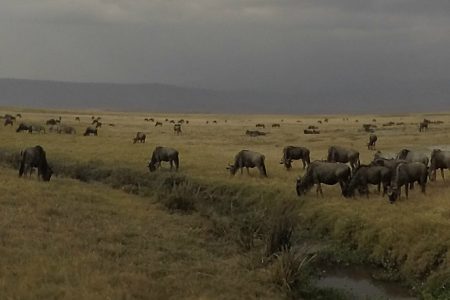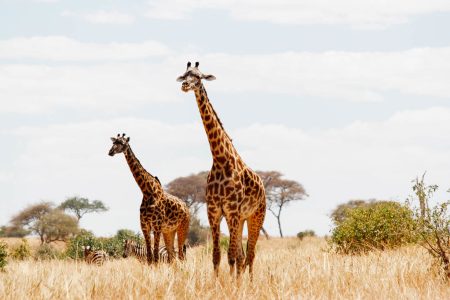One of the 7 wonders of the world (The Northern Wildlife Circuit of Tanzania)
This Northern circuit is filled with an unforgettable adventure comprising of the following;
The Great Wildebeest Migration (Wildebeest migration), the Big Five, is the full experience of Arusha, Tarangire, Ngorongoro crater, Lake Manyara Lake Natron, and Hadzabe Tribe. Each of these national parks presents you with a natural uniqueness.
What is the best time/month to embark on the Tanzanians’ Northern Circuit?
From early May to September, you are to experience the Wildebeest migration depending on the weather forecast. Therefore, one needs over 7 days for this destination because the immigration is seasonal and therefore, weather-dependent, they migrate during hot times crossing from Serengeti to Mara. You will encounter crowds because it is an adventure that many people seek. The best accommodation option would be budget, luxury bush, or wild camping since the beasts don’t have a particular crossing spot.
The World’s Greatest Wild Beast Migration (Wildebeest migration)
The world’s greatest and largest wild beast migration is in Tanzania and Kenya in East Africa. Large herds of wild beasts characterize it; over millions migrating from one habitation to another.
What is wild beast (Wildebeest migration) migration?
Wild beast migration is the movement of large herds of wild beasts from a less comfortable area to a more comfortable area. This is a Great Migration that occurs every year through Tanzania and Kenya. It is the largest overland wildlife migration in the world involving the movement of over 2 million wildebeest, gazelles and Zebras, these move over 800 kilometres for the entire course of migration. Animals can move as much as 45 kilometres per day during this migration. This migration is also long-awaited not only by tourists but also by predators such as lions, and crocodiles among others in the Mara and Grumeti Rivers that wait to make a meal of the weary and weak prey.
Animals, just like humans, prefer places where their lives are exciting and catered for as much as possible. When the conditions do not provide the desired livelihood, migration takes place. Animals are susceptible to climatic and weather changes; they have mastered the precursor conditions for weather changes; living weather forecasters. Besides safety, the major needs of wild beasts are food and water. During the dry seasons, some areas face a big challenge since the grasslands and seasonal rivers tend to dry up and this marks a drought and famine for these animals. These beasts have now mastered the seasons and times and therefore at particular times they cross to the end that tends to provide for their needs.
Why do wildebeests migrate?
During the wet season, the flood plains of Serengeti become flooded and unbearable for the animals because excess water affects their hooves, so they migrate to the Ndutu area, when the flooding reaches Ndutu the animals can no longer be comfortable. This drives them to cross the Mara River to the side of the Masai Mara area which is rich in both water and vegetation and is free from floods. During the dry spell, the vegetation in the Masai Mara region dries up and the seasonal water bodies also dry up. Thus, animals have no food and water, by this time the Serengeti and Ndutu flood plains have dried up so the grass is fresh and green, and the land is dry and conducive. The Ndutu region is also very conducive for calving because it has caves and safe hiding for the safety of the young ones while it also has salt which animals love to lick as part of their diet.
When do the Wildebeests Migrate?
The timing of the great migration is essentially dependent on the Serengeti-Masai Mara ecosystem. This is a region of East African equatorial savannah, situated in the north of Tanzania and southwest Kenya and is approximately 30,00 km sq. The area is comprised of Serengeti National Park in Tanzania and Masai Mara National Park and Conservancy in Kenya including game reserves such as Maswa Game Reserve, Loliondo game controlled area, Grumeti Reserve in Kenya and Ngorongoro Conservation Area. The great migration is significant at the onset of the major rainy and dry spells, thus the best period to witness the wildebeest migration is September to October each year. This event is mainly driven by weather, more specifically rainfall. Different herds are susceptible to moving at particular periods therefore knowing their general responses to weather changes gives a chance to anticipate the kind of animals to see in a particular period of migration as summarized below
January
This period is characterized by rain-plump grass in the deep south of the Serengeti National Park available to feed the huge herds, not only of wildebeest but hundreds of thousands of gazelle, zebra and other antelopes. The herds congregate around the Ndutu section of the Ngorongoro Conservation Area, with the best sightings around Lobo and Naabi Hills. This is also the beginning of calving season and the place offers the best safety for the young ones.
Huge herd of wildebeest congregating in Ndutu (PHOTO)
February
The females give birth during the short grass plains that surround Lakes Maek and Ndutu in February. During this time, hundreds of thousands of wildebeest are born, with a peak birth rate of roughly 8,000 per day. In southeast Ndutu, the herds remain stationary after the birth of calves, leaving herds of wildebeest as far as the eye can see. This forces the numerous predators to act to get their fill.
March
As the southernmost Serengeti’s short grass plains start to dry out, the herds complete their calving. With the young in tow, they start to head west toward the woodlands, where the brief afternoon rains are starting.
A wildebeest calf feeds before the long journey ahead (photo)
April
At this point, Tanzania is unmistakably experiencing its rainy season, with the wettest hours being late afternoon and night-time. Instead of congregating in high concentrations during the calving season, the herds divide into smaller groups and move northwest into Moru and the southern Serengeti plains.
May
The “long rains” continue to occur every day, however, the herds are able to cover more ground and travel more quickly as the calves get stronger. They are now beginning to gather in the Western Corridor of the Serengeti, herding along the Grumeti River’s channels and pools in preparation for crossing the crocodile-infested river.
Wildebeest crossing the Grumeti River (n photo)
June
The rains are ending, and the herds are moving northward in vast lines from the Western Corridor to the Serengeti’s centre. While one party proceeds straight north through Seronera to the Serengeti, the other group crosses the Grumeti and passes through the Singita Grumeti Reserve. With the front-runners at the Mbalageti River and the stragglers near Lake Magadi, the herds are currently overextended.
July
As the herds continue to move north across the plains, July is a raucous time to watch them as they enter the actual mating season. The herds are primarily located west of the Serengeti, in the Grumeti Reserve, and continue to move in independent groups.
August
The herds are currently in the Kogatende area of the northern Serengeti, where they are beginning to attempt the difficult task of crossing the swift-moving Mara River. With the iconic scene of closely spaced herds of wildebeest pushing one another down steep riverbanks to attempt the river crossing over crocodile-infested waters, this is prime drama (and tourist) time. Every year, thousands of wildebeest die at the Mara crossing as a result of drowning, crocodile predation, slipping down the high banks, or being crushed or trampled by the herd’s size.
September
Now that the last of the herds have crossed the Mara River, the weather is scorching and dry. Following local rainfall in the Masai and Northern Serengeti, the herds re-assemble once they cross the river.
October
With the hectic river crossing over for another year and the massive herd together reaping the benefits of new grazing grounds in the Masai and Northern Serengeti, October is a rather calm month. The “short rains” begin toward the end of October, and the herd begins to migrate south. The herd of wildebeests advances on the new, verdant grasses of the Masai Mara in Kenya.
November & December
The herds depart Kenya and travel south to western Loliondo and the Lobo region in Serengeti National Park as a result of the “short rains,” which sets off a new cycle. As they head for the fertile Ndutu plains, where the rains will have restored the grasses since the herds were last there, the herds divide into smaller family groupings at this stage of the migration to ensure they have enough food.

3 days Wildebeest Migration Safari in Ndutu region
3 days Wildebeest Migration Safari in Ndutu region is designed for travelers seeking to witness the calving season of the great wildebeest migration in the Serengeti. The great wildebeest migration is a cyclical movement that traverses Serengeti National Park and proceeds to Masai Mara via the Mara River, culminating in the renowned Mara River crossing,

16 Days best of Tanzania Safari in the Northern Circuit.
16 Days best of Tanzania Safari in the Northern Circuit, Have you got plenty of time on your hands anyway, decision-making isn’t your thing or has it not been easy? Then you should definitely choose this itinerary, since it expertly incorporates all the elements that a Tanzanian safari visitor may desire. If you are interested in visiting Tanzania’s northern parks,

11 Days safari trip to tanzania zanzibar
Join us for an 11-day Tanzania Safari & Zanzibar vacation to witness the hypnotic beauty of Tanzania. Enjoy your stay in Tanzania to the fullest. Embark on an African safari and see exotic animals up close, or relax on Zanzibar’s lush beaches. Get to know Tanzania at your leisure on this private, luxurious safari. With the help of your knowledgeable English-speaking

7 Days Serengeti Hot Air Balloon and Gorillas
7 Days Serengeti Hot Air Balloon and Gorillas, you will embark on a mind-blowing safari adventure to one of the most visited destinations in Tanzania, Serengeti National Park, best known for its amazing wildlife viewing adventures and awe-inspiring hot air balloon safaris. It will also take you across borders

4 Days Serengeti and Ngorongoro Crater Safari
The 4 Days Serengeti and Ngorongoro Crater safari is a highlight to Tanzania’s popular and unique national parks. The trip takes you in to Serengeti national park and Ngorongoro where you will be able to spot a variety of animals. Both Ngorongoro Crater and Serengeti are UNESCO world heritage sites

3 days Arusha, Ngorongoro and Lake Manyara wildlife safari
3 days Arusha, Ngorongoro and Lake Manyara wildlife safari will take you to the vicinity of Mount Meru, which stands at 4,565 meters, as well as the Ngurdoto Crater and Momella Lakes. The park offers the most exceptional vistas of Mount Kilimanjaro relative to any location in Tanzania.